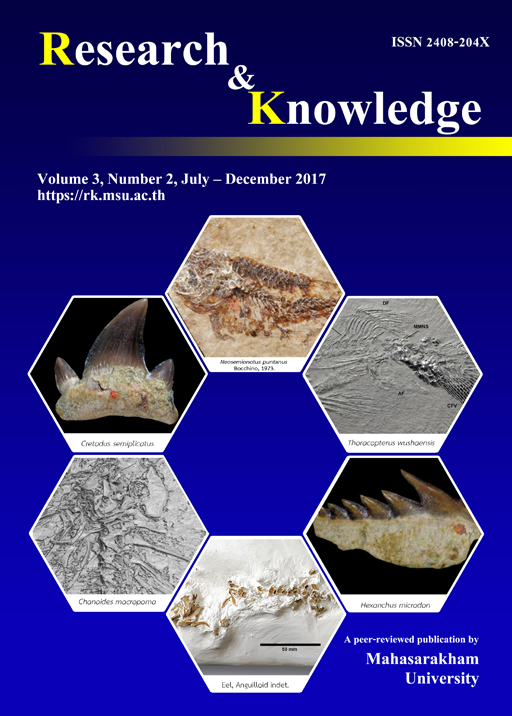The invention of fast-start predation: hydrodynamics of the predator-prey interaction in Triassic saurichthyids (Actinopterygii, ‘Palaeopterygii’)
Keywords:
Hydrodynamic modeling, Fast-start predation, Convergence, Computational fluid dynamics, SaurichthysAbstract
The essentially Triassic Saurichthyidae are the earliest known ray-finned fishes characterized by elongate, slender bodies; posteriorly situated median fins; symmetrical tails; and elongate, pointed heads with long jaws bearing a typical predatory dentition. In recent fishes, this morphology is usually associated with a fast-start predatory lifestyle. Finds of fossil saurichthyids with preserved prey items document piscivory at least in the larger forms. Anatomical studies reveal that saurichthyids possessed large orbits and optic tecta, indicating an elaborate sense of vision crucial to perform target-oriented predatory strikes. Their locomotor system was optimized for acceleration. Hydrodynamic modeling shows that a moving Saurichthys caused only little disturbance to the surrounding water, preventing prey fishes from detecting the approaching predator by their lateral line system.
References
Brough, J. 1936. On the evolution of bony fishes during the Triassic period. Biological Reviews 11, 385-405.
Domenici, P. and Blake, R. W. 1997. The kinematics and performance of fish fast-start swimming. Journal of Experimental Biology 200, 1165-1178.
Feilich, K. L. and Lauder, G. V. 2015. Passive mechanical models of fish caudal fins: effects of shape and stiffness on self-propulsion. Bioinspiration & Biomimetics 10, 036002.
Frith, H. R. and Blake, R. W. 1995. The mechanical power output and hydromechanical efficiency of northern pike (Esox lucius) fast-starts. Journal of Experimental Biology 198, 1863-1873.
Hale, M. E. 1996. The development of fast-start performance in fishes: escape kinematics of the Chinook salmon (Oncorhynchus tshawytscha). American Zoologist 36, 695-709.
Higham, T. E., Stewart, W. J. and Wainwright, P. C. 2015. Turbulence, temperature, and turbidity: the ecomechanics of predator-prey interactions in fishes. Integrative and Comparative Biology 55(1), 6-20.
Kogan, I. and Licht, M. 2013. A Belonostomus tenuirostris (Actinopterygii: Aspidorhynchidae) from the Late Jurassic of Kelheim (southern Germany) preserved with its last meal. Paläontologische Zeitschrift 87(4), 543-548.
Kogan, I., Pacholak, S., Licht, M., Schneider, J. W., Brücker, C. and Brandt, S. 2015. The invisible fish: hydrodynamic constraints for predator-prey interac - tion in fossil fish Saurichthys compared to recent actinopterygians. Biology Open 4, 1715-1726.
New, J. G., Alborg Fewkes, L. and Khan, A. N. 2001. Strike feeding behavior in the muskellunge, Esox masqui - nongy: contributions of the lateral line and visual sensory systems. Journal of Experimental Biology 204, 1207-1221.
Maxwell, E. E. 2016. First Middle Jurassic record of Sau - richthyidae (Actinopterygii). Paläontolgische Zeitschrift 90(2), 287-291.
Renesto, S. and Stockar, R. 2015. Prey content in a Sau - richthys reveals the presence of advanced haleco - morph fishes in the Middle Triassic of Monte San Giorgio. Neues Jahrbuch für Geologie und Paläon - tologie – Abhandlungen 278(1), 95-107.
Romano, C., Kogan, I., Jenks, J., Jerjen, I. and Brinkmann, W. 2012. Saurichthys and other fossil fishes from the late Smithian (Early Triassic) of Bear Lake County (Idaho, USA), with a discussion of saurichthyid palaeogeography and evolution. Bulletin of Geosci - ences 87(3), 543-570.
Weihs, D. 1973. The mechanism of rapid starting in slen - der fish. Biorheology 10, 343-350. Weihs, D. 1989. Design features and mechanics of axial locomotion in fish. American Zoologist 29, 151-160.
Werneburg, R., Kogan, I. and Sell, J. 2014. Saurichthys (Pisces: Actinopterygii) aus dem Buntsandstein des Germanischen Beckens. Semana 29, 3-35.
Downloads
Published
How to Cite
Issue
Section
License

This work is licensed under a Creative Commons Attribution-NoDerivatives 4.0 International License.







